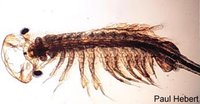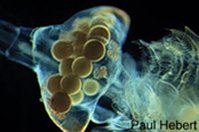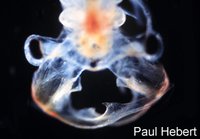
(Source: Biodiversity Institute of Ontario)
| Branchiopoda | ||
| Arthropoda | Anostraca |
| Arthropoda | Eucrustacea
└─► |
|||
| Labrophora | None |
Maxillopoda |
|
Abbreviated Dendrogram
Crustacea
├─Phosphatocopida
└─┬─Branchiopoda
│ ├─Anostraca
│ └─┬─Notostraca
│ └─┬─Conchostraca
│ └─Cladocera
├?─Xenocarida
╘═╤═Maxillopoda
├─Ostracoda
└─Malacostraca
|
Contents
Overview |
Taxa on This Page
This content on this page copied verbatum from Encyclopedia of Earth - Crustacea under Creative Commons Attribution Share-Alike license. It is intended at some point to add additional material on evolution, paleontology, etc MAK120517
 (Source: Biodiversity Institute of Ontario) |
Fairy shrimp are easy to distinguish from all other branchiopods because they swim upside down with their legs extending upwards. They occur in temporary freshwater ponds from the arctic circle to southernmost Canada.
 (Source: Biodiversity Institute of Ontario) |
Distinguishing characteristics of fairy shrimp are the absence of a carapace, an elongate body and distinct head region. They have a pair of stalked compound eyes and 11, 17 or 19 pairs of thoracic legs. The largest fairy shrimp are 100 mm long, though most species are between 7 and 20 mm. Anostracans are sexually dimorphic; the males have a pair of ventral penes on their genital segments, while the females have a ventral, medial brood pouch to hold their eggs.
 (Source: Biodiversity Institute of Ontario) |
 (Source: Biodiversity Institute of Ontario) |
Anostracans usually reproduce sexually, though parthenogenetic reproduction occurs in some populations of Artemia salina, the brine shrimp. Mating usually occurs just after the female has moulted, so nearly mature females are often attended by several males. After mating, the female retains the eggs in her brood pouch until she dies, and the eggs settle to the bottom. The eggs are resistant to dessication, freezing, and ingestion by birds. The eggs hatch into nauplius or metanauplius larvae which undergo several moults before reaching maturity. Species that live in temporary ponds typically only have one generation per year.
 (Source: Biodiversity Institute of Ontario) |
Fairy shrimp are restricted to temporary pools of freshwater during the cool months of the year. They are not usually found in habitats that contain fish. Algae, bacteria, protozoans, rotifers, and bits of detritus constitute most of their diet, but large species, such as Branchinecta gigas, are predators.
 (Source: Biodiversity Institute of Ontario) |
Many species of fairy shrimp compete intensely for mates. Since mating usually occurs just after the female moults, males often grasp her and are towed around while waiting for her to moult. Some females have a chain of these attached males, including some which have died while awaiting her moult!
From "Crustacea", Encyclopedia of Earth. Eds. Cutler J. Cleveland (Washington, D.C.: Environmental Information Coalition, National Council for Science and the Environment) 100219; revised 110529; Creative Commons Attribution Share-Alike